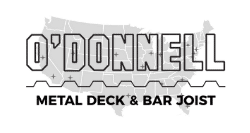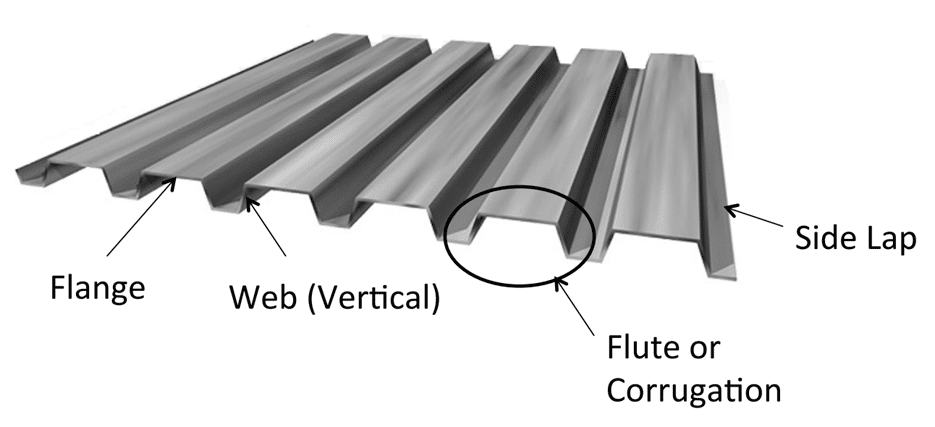
What is Metal Decking?
Metal deck is a key structural building component in steel construction typically found in commercial construction.
Metal Deck is made by rolling steel coil to corrugated rolled to a specified geometry. Thus, deck is made by cold forming structural grade steel coils into a pattern of flutes and ribs into various shapes. These various shapes are called profiles. These different metal deck profiles are specified by engineers for specific design requirements.
Each unique profile (the shape of the corrugation) and gauge (the thickness of steel used the profile) produces different material properties. As the corrugations of the steel give each profiles it’s unique strength, engineers specify to maximize the steel decks strength to weight ratio for efficient design applications. Or said another way, the strength and stiffness of the steel deck panels are a combination of the shape of the ribs and the material properties of the steel.
What is Metal Deck Used For?
Numerous SDI (Steel Deck Institute) certified profiles are available in various gauges & finishes which allow for specification across many design applications. Deck is available with and without stiffening ribs, optional acoustical sound dampening, in either cellular and non-cellular profiles. The wide variety makes steel deck applicable to a wide range of structural designs and projects. Most commonly metal decking is used to support roof systems of a building, mezzanines or intermediate floors in a building, steel canopies to provide shade and shelter, or floors in commercial structures.
Benefits of Specifying Steel Deck
Performing satisfactorily for nearly 100 years is indicative of the product's durability and functionality in commercial design and application.
Value
Metal decking’s lower total cost of ownership and value when combining material costs, erection and installation, time, life-cycle costs, and overall performance. Steel deck provides the best value in with high performance.
Speed of Construction
Steel deck is capable of being installed or erected in most weather conditions. Specifying steel deck can eliminate delays that may occur with other types of building systems.
Steel
The design properties of metal deck allow the EOR to to maximum steels strength and efficiency. Deck products and applications have an extremely high strength to-weight ratio and thus total costs of construction can be lower than with other building systems with less total weight.
Versatility
Numerous SDI (Steel Deck Institute) certified profiles are available in various gauges & finishes which allow for proper specification across many design applications. Deck with and without stiffening elements, acoustical dampening, cellular and non-cellular. Steel deck applicable to a wide range of structural designs and projects.
UL Fire Ratings
Most UL fire resistance rating requirements can be met with products manufactured by O’Donnell Metal Deck.
Quality
Superior production techniques and Engineering standards allows O’Donnell Metal Deck to supply steel deck that conform to ANSI/SDI specified standards.
Types of Steel Decking
Metal Roof Deck
The purpose of metal roof deck products are to serve as the structural base for roofing membranes in commercial roof construction. Typically, steel roof deck is installed directly over structural steel supports to provide a working platform and to allow for the installation of insulation, weatherproofing, and other roofing materials. Additionally metal roof deck encloses a building from wind, it provides the necessary fire resistance for a UL roof assembly while snow loads, live loads, dead loads and or seismic & wind loads.
Roof Decking
Metal roof deck transfers wind loads to vertical elements of lateral force resisting systems through diaphragm action which is what makes the properties of roof deck specification unique. Steel roof decks differ in their way of resisting horizontal force, also called shear diaphragm from composite decks or form deck.
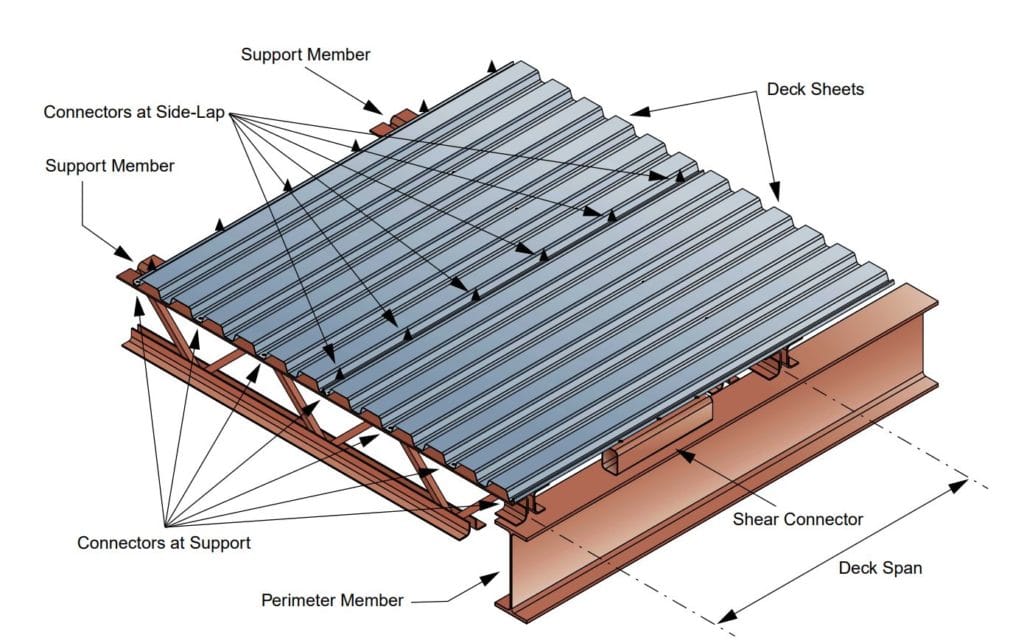
Floor Decking
Floor decking is used for pouring a concrete floor and support for concrete during the curing process. Roof decking doesn’t have the ability to provide the same support as floor decking. A floor deck purpose is for supporting concrete while roof decking can be used for many different things. While they share similarities such as originating from the same materials, are designed to be lightweight, and manufactured in the same manner. There are two types of floor decks. Composite decking which includes embossments which creates composite slab action, and form decking which is merely a Permanente form for concrete but does not have composite action.
Composite Deck
Composite steel floor deck has a ribbed profile with embossments designed to interlock with concrete slabs, creating a reinforced concrete slab that serves the dual purpose of permanent form and positive reinforcement. Most commonly interlocking composite metal floor deck is used in a variety of commercial applications.
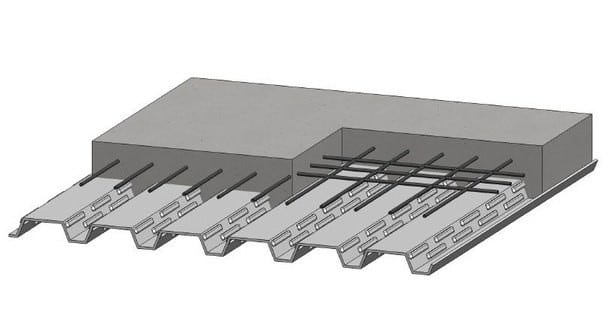
Non-Composite Deck
Form deck provides a strong, safe, secure stay in-place form for poured concrete slab designs and applications. Installation is quick, easy and economical. There forms are designed to serve as a permanent steel pan to hold concrete with reinforcement. Structurally form deck creates an easy way of forming slabs, while providing required lateral stability to structural members.
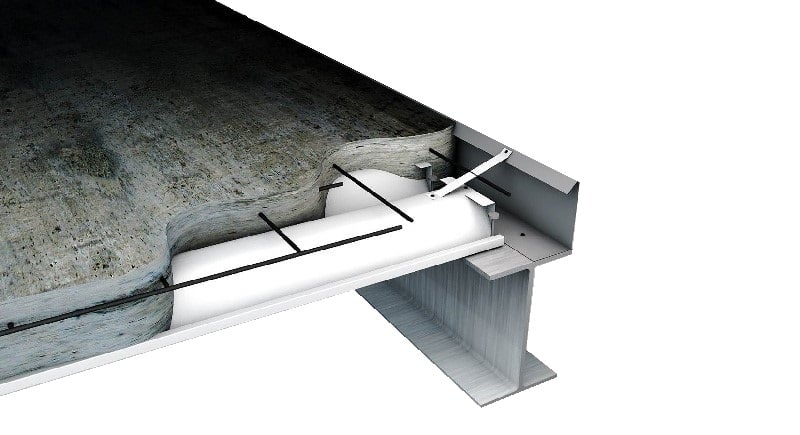
Gauges for Metal Deck
As shown below, the gauge or thickness of the metal deck is the main driver for structural integrity for any deck product. It's also the main driver of cost for metal decking.. Therefore In simple terms, more heavier the deck gauges the more the steel deck will cost. A heavier the deck gauge is essentially more steel and very likely to be more expensive compared to a simlar product with a lesser gauge. Inversely the opposite it true, a thinner or lighter deck gauge will likely reduce the cost of the metal deck. Therefore it is critical that the (EOR) is optimizing for cost in a steel deck design and specifying the correct gauge without over specifying the steel deck requirements.
Finally, if you are unsure of what gauge of metal deck is required or have questions it’s always appropriate to request the EOR to dictate this. While O’Donnell Metal Deck is capable of assisting design --- O'Donnell Metal is is not a structural engineering firm and we do not own liability for customer requests.
What Does The Gauge Mean?
The metal deck gauge is a unit of measurement that refers to the thickness of the steel. The higher the gauge number the thinner the steel. The lower the gauge number the thicker or heavier the steel is.
Example 1:
16 gauge is thicker, and therefore stronger & heavier than 22 gauge steel
Example 2:
22 gauge is thinner, and therefore lighter & weaker than 18 gauge steel

What Gauge Do I Need?
The (EOR) or Engineer of Record should be dictating the steel deck gauge requirement for the specific job requirements. However, typically the deck gauge will depends on the below factors:
- Load capacities and/Concrete slab capacities
- Span capabilities of the deck during or after construction
- Diaphragm shear values
Types of Metal Deck Finishes
Metal deck primer is applied to provide provisional protection for short periods of exposure. Therefore, uncoated steel with paint should only be considered a temporary coating not a finished product. A final coating is recommended as handling, transportation and jobsite conditions are expected to impact the quality of the finish.
Galvanized metal decking exposed to ordinary atmospheric conditions does not need to be field painted for structural purposes. Often times, painting galvanized deck is desired for astechtic purposes. It’s important to note that proper steps are taken to ensure proper adhesion to galv coils if a primer is not applied at the factory. Various oils or chemicals used to prolong the life of the coil may impact paints ability to adhere properly.
On rare occasion for composite floor deck – a uncoated steel sometimes referred to as Phos-painted maybe specified. This composite deck is painted with primer on the bottom side, and either galvanized steel, bare steel on top. It is imperative that phos/painted composite deck do not have paint on top of the deck as the bonding action between concrete and steel will be adversely affected by painting the surface of a composite deck where it meets the slab.
Since bonding action is not necessary for non-composite form decks, they may be painted on one or both sides. Form decks that are non-structural after the overlying concrete slab is cured may be made from steel that is uncoated on both sides. Uncoated steel is sometimes referred to as “black,” which does not imply that it is painted with black-colored paint
![]()
Galvanized
The zinc coating acts as the protective barrier between the steel and the environment. Typically deck specified as G-30,G-60 or G-90.
![]()
Non-Galvanized or "Cold Rolled"
Uncoated steel, painted with primer. Metal deck primer is applied to provide provisional protection. Commonly grey/grey or grey/white.
![]()
Galvanized Base & Primer Painted
Galvanized (G-30,G-60, G-90) base coil with a special baked on enamel primer paint in grey/grey or grey/white .
All our products are in conformance with Steel Deck Institute (SDI) standards and in conformance with American Iron and Steel Institute ANSI/SDI standards.
| ASTM Specification | A653 | A1008 | A653 |
|---|---|---|---|
| Finish | GALVANZIED | NON GALVANZIED-PAINTED | GALVANZIED & PAINTED |
| Galvanized G-30 | X | ||
| Galvanized G-60 | X | ||
| Galvanized G-90 | X | ||
| CR Painted G/G | X | ||
| CR Painted G/W | X | ||
| Galv & Grey/Grey | X | ||
| Galv & Grey/White | X |
